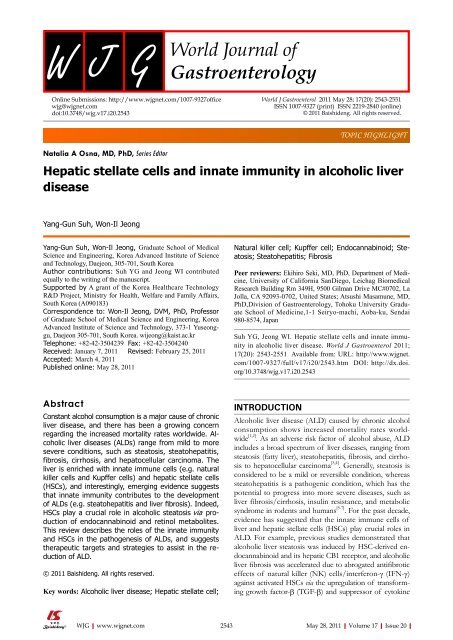20 - World Journal of Gastroenterology
20 - World Journal of Gastroenterology
20 - World Journal of Gastroenterology
Create successful ePaper yourself
Turn your PDF publications into a flip-book with our unique Google optimized e-Paper software.
Online Submissions: http://www.wjgnet.com/1007-9327<strong>of</strong>fice<br />
wjg@wjgnet.com<br />
doi:10.3748/wjg.v17.i<strong>20</strong>.2543<br />
Natalia A Osna, MD, PhD, Series Editor<br />
Hepatic stellate cells and innate immunity in alcoholic liver<br />
disease<br />
Yang-Gun Suh, Won-Il Jeong<br />
Yang-Gun Suh, Won-Il Jeong, Graduate School <strong>of</strong> Medical<br />
Science and Engineering, Korea Advanced Institute <strong>of</strong> Science<br />
and Technology, Daejeon, 305-701, South Korea<br />
Author contributions: Suh YG and Jeong WI contributed<br />
equally to the writing <strong>of</strong> the manuscript.<br />
Supported by A grant <strong>of</strong> the Korea Healthcare Technology<br />
R&D Project, Ministry for Health, Welfare and Family Affairs,<br />
South Korea (A090183)<br />
Correspondence to: Won-Il Jeong, DVM, PhD, Pr<strong>of</strong>essor<br />
<strong>of</strong> Graduate School <strong>of</strong> Medical Science and Engineering, Korea<br />
Advanced Institute <strong>of</strong> Science and Technology, 373-1 Yuseonggu,<br />
Daejeon 305-701, South Korea. wijeong@kaist.ac.kr<br />
Telephone: +82-42-3504239 Fax: +82-42-3504240<br />
Received: January 7, <strong>20</strong>11 Revised: February 25, <strong>20</strong>11<br />
Accepted: March 4, <strong>20</strong>11<br />
Published online: May 28, <strong>20</strong>11<br />
Abstract<br />
Constant alcohol consumption is a major cause <strong>of</strong> chronic<br />
liver disease, and there has been a growing concern<br />
regarding the increased mortality rates worldwide. Alcoholic<br />
liver diseases (ALDs) range from mild to more<br />
severe conditions, such as steatosis, steatohepatitis,<br />
fibrosis, cirrhosis, and hepatocellular carcinoma. The<br />
liver is enriched with innate immune cells (e.g. natural<br />
killer cells and Kupffer cells) and hepatic stellate cells<br />
(HSCs), and interestingly, emerging evidence suggests<br />
that innate immunity contributes to the development<br />
<strong>of</strong> ALDs (e.g. steatohepatitis and liver fibrosis). Indeed,<br />
HSCs play a crucial role in alcoholic steatosis via production<br />
<strong>of</strong> endocannabinoid and retinol metabolites.<br />
This review describes the roles <strong>of</strong> the innate immunity<br />
and HSCs in the pathogenesis <strong>of</strong> ALDs, and suggests<br />
therapeutic targets and strategies to assist in the reduction<br />
<strong>of</strong> ALD.<br />
© <strong>20</strong>11 Baishideng. All rights reserved.<br />
Key words: Alcoholic liver disease; Hepatic stellate cell;<br />
WJG|www.wjgnet.com<br />
<strong>World</strong> J Gastroenterol <strong>20</strong>11 May 28; 17(<strong>20</strong>): 2543-2551<br />
ISSN 1007-9327 (print) ISSN 2219-2840 (online)<br />
© <strong>20</strong>11 Baishideng. All rights reserved.<br />
Natural killer cell; Kupffer cell; Endocannabinoid; Steatosis;<br />
Steatohepatitis; Fibrosis<br />
Peer reviewers: Ekihiro Seki, MD, PhD, Department <strong>of</strong> Medicine,<br />
University <strong>of</strong> California SanDiego, Leichag Biomedical<br />
Research Building Rm 349H, 9500 Gilman Drive MC#0702, La<br />
Jolla, CA 9<strong>20</strong>93-0702, United States; Atsushi Masamune, MD,<br />
PhD,Division <strong>of</strong> <strong>Gastroenterology</strong>, Tohoku University Graduate<br />
School <strong>of</strong> Medicine,1-1 Seiryo-machi, Aoba-ku, Sendai<br />
980-8574, Japan<br />
Suh YG, Jeong WI. Hepatic stellate cells and innate immunity<br />
in alcoholic liver disease. <strong>World</strong> J Gastroenterol <strong>20</strong>11;<br />
17(<strong>20</strong>): 2543-2551 Available from: URL: http://www.wjgnet.<br />
com/1007-9327/full/v17/i<strong>20</strong>/2543.htm DOI: http://dx.doi.<br />
org/10.3748/wjg.v17.i<strong>20</strong>.2543<br />
INTRODUCTION<br />
TOPIC HIGHLIGHT<br />
Alcoholic liver disease (ALD) caused by chronic alcohol<br />
consumption shows increased mortality rates worldwide<br />
[1,2] . As an adverse risk factor <strong>of</strong> alcohol abuse, ALD<br />
includes a broad spectrum <strong>of</strong> liver diseases, ranging from<br />
steatosis (fatty liver), steatohepatitis, fibrosis, and cirrhosis<br />
to hepatocellular carcinoma [3,4] . Generally, steatosis is<br />
considered to be a mild or reversible condition, whereas<br />
steatohepatitis is a pathogenic condition, which has the<br />
potential to progress into more severe diseases, such as<br />
liver fibrosis/cirrhosis, insulin resistance, and metabolic<br />
syndrome in rodents and humans [5-7] . For the past decade,<br />
evidence has suggested that the innate immune cells <strong>of</strong><br />
liver and hepatic stellate cells (HSCs) play crucial roles in<br />
ALD. For example, previous studies demonstrated that<br />
alcoholic liver steatosis was induced by HSC-derived endocannabinoid<br />
and its hepatic CB1 receptor, and alcoholic<br />
liver fibrosis was accelerated due to abrogated antifibrotic<br />
effects <strong>of</strong> natural killer (NK) cells/interferon-γ (IFN-γ)<br />
against activated HSCs via the upregulation <strong>of</strong> transforming<br />
growth factor-β (TGF-β) and suppressor <strong>of</strong> cytokine<br />
2543 May 28, <strong>20</strong>11|Volume 17|Issue <strong>20</strong>|

















